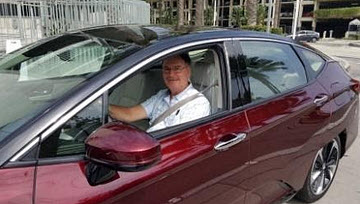Creating the hydrogen gas station network for the Ford F150 LightningH
June 16, 2021From here to there and back again…
If the Ford F150 Lightning Project Manager Linda Zhang read the June 1st Hydrogen Fuel News article describing a hydrogen-powered 1000-mile LightningH. (https://tinyurl.com/33syb2dz), she may be converting their EV truck into a long-distance cruiser as we speak. 😉 When Ford gets it right, the LightningH will quickly replace the incredibly popular gasoline-powered F150 and could sell a million copies a year, with 10 million on our highways by 2035.
But – Those clean and green trucks won’t sell rapidly without reliable access to fuel. To avoid a cooler-climate bottleneck, let’s jump-start a country-wide hydrogen network right now.
Where to begin?
The long-haul trucking industry will build an initial set of hydrogen stations to power their upcoming self-driving big rigs. I talked with their reps at a SEPA conference 2 1/2 years ago — they said they’d be happy to fuel our smaller vehicles, too. But, they’ll focus first on a few highways: I-10, I-40… the good-weather, high-value arteries. Let’s instead build our own network – one that can refuel a long-distance hydrogen vehicle anywhere in the U.S. That’s the jump-start that’s been missing. Elon did it for Tesla – he’s approaching a thousand Supercharger stations in the U.S. alone. Let’s begin with 10% of that number and grow it from there.
The U.S. has a huge advantage – a wonderful Interstate highway system with four lanes not far from anyone. (Thanks, Ike!) That’s where Ford and the USDOE’s Jennifer Granholm and Jigar Shah should team up to subsidize rapid installations of hydrogen fuel stations. They can offer funds & extended incentives to 100 service stations that have the space to install an electrolyzer (the gadget that extracts hydrogen from water) and some hydrogen storage tanks. (While we’re at it, let’s be sure to standardize the hydrogen pumps such that any brand of H-powered vehicle will be able to easily tap in. The battery-vehicle charging network has developed without that feature – it’s a bit complicated as a result.)
The total cost of our 100 H-stations will be about $320 million, based on an NREL article. That’s a reasonable investment to provide deal-making support for a huge new industry. The stations will have ever-increasing access to green (zero-CO2) electricity. (More on that in a future article. Hint: It will involve high-voltage DC power lines fed by solar panels in the southwest and wind turbines in the heartland.) The H-stations will extract and store hydrogen from water on-the-spot, often relieving the grid of excess electricity when wind and solar produce more than other customers can use.
Given the LightningH’s thousand-mile range, let’s consider what first-adopters (like you and me, I suspect) might like to see on a “HydroGen Station, Version 1” map. At a minimum and just to get the trucks rolling, I’d like to have fuel within 200 miles of anywhere I drive. When I’m towing a travel trailer and my range is reduced to 500 miles, I could comfortably arrive with plenty to spare. (I could also park the trailer to regain full range, but let’s not make things difficult.) 😉 To meet a goal of less than 200 miles to a station, our map fills out as shown below. (Note: California already has about 50 H-stations operating on their hydrogen highway. That’s great, but let’s keep our map simple for the moment.)

Our “starter” network of hydrogen fuel stations
This looks like a lot of stations, but there are now about 110,000 gasoline stations in the U.S. As we evolve to an all-electric country, we’ll gradually replace those with perhaps 2500 H-stations by 2050’s E-equilibrium.
Why the huge decrease in gas stations over the next few decades? Within a decade or two, most around-town traveling will be via millions of small, shared, on-demand self-driving electric cars, with longer-range E-vans covering the routine intercity commutes. (See the https://www.poweringaplanet.com post titled “A Tale of Two Commutes”.) Given tap-a-cellphone access to an Uber-like driverless vehicle waiting a few blocks away, with no need to park downtown and a tap-a-phone ride back home with the groceries and kids, transportation will be quick and convenient. These vehicles will have no need for gasoline stations. The expense of owning a second car will no longer make much sense, and trips for those who don’t drive will be simple and safe as well. The hydrogen refueling stations will be there to support longer trips. And, H-refueling with your solar-powered home electrolyzer will be standard fare by then, too.
The fleet of H-vehicles will become a backbone of the renewable economy, supplying electricity to the grid whenever when solar and wind output drops off. The F150 Lightning platform has been designed by Ford to back up our electrical grid needed. Ten million 580 kWh LightningH’s parked throughout the country, incentivized and volunteered to help when the Smart Grid calls, could make up to 5000 GWh available when needed. (More on that in a future article, but for now: That’s a LOT of nicely distributed energy storage.)
With our 100-station investment supporting vehicles like the long-distance LightningH, range anxiety will dwindle. Given the advantages built into the Lightning platform (read that June 1st HFN article again, please) and expansion of financial incentives encouraging us to buy electric, why would I ever again drive a gasoline-burner?
Author’s Notes: The map above represents a quick look at what should be sufficient to encourage early purchases of the LightningH. As California has learned, it’s hard to sell HCars if the hydrogen supply isn’t reliable. We can avoid that deal-breaker by producing hydrogen at the gas stations. Also – ongoing research should greatly improve both the efficiency and safety of hydrogen storage, soon. The airlines are awaiting that breakthrough to allow long-distance electric trips on the sky highways.

The author, Dr. H. Robert Meyer, seen here driving a hydrogen-powered demo at a SEPA energy conference, is an environmental scientist with decades of experience. After serving as a Navy Officer he began his career at the Oak Ridge National Laboratory then moved on to run large projects around the country. His background in physics, environmental protection and alternative energy helps unravel the complexities of converting a planet to all-electric. His website at https://poweringaplanet.com is focused on the tough-to-grasp size of the CO2 reduction problem — the effort required to reverse climate change is not yet widely understood. We need to drastically ramp up the installation rates of green energy and its backups to get to zero emissions before time runs out.



 With over 15 years of reporting hydrogen news, we are your premier source for the latest updates and insights in hydrogen and renewable energy.
With over 15 years of reporting hydrogen news, we are your premier source for the latest updates and insights in hydrogen and renewable energy.
Come on Warren Buffet, add these stations to your Flying J/Pilt Truckstops and be an American Hero!
The H2 fueling station issue is exactly what needs to be addressed if FCEV’s are ever going to be allowed to make the impact they have the potential to make. It’s great to see that someone with your experience, knowledge and vision is promoting so!utions to this problem. Now where are the folks with the money and power?
Thanks, Russell – There are a half-dozen battery-powered full-size pickups about to hit the market, at least per the articles I’m seeing. None look to have a useful range when towing, and a truck that doesn’t tow isn’t of much use to the millions of us who do.
With the reasonably detailed info released by Ford for the Lightning, the problem with batteries in larger vehicles has been brought into focus. The Lightning would need more than 3 tons of batteries to have a towing range similar to my gasoline F150. That’s not going to happen. It’s suddenly clear that hydrogen can handle this problem, batteries can’t.
Issues with the end-to-end efficiency of hydrogen power don’t matter much when it’s the only way to get the job done. We didn’t really know that until the battery-powered Lightning’s specifications appeared. -Bob
The big truckstops ought to be able to add hydrogen fueling stations easily – agreed. 🙂